MRE5003 Industrial Techniques In Maintenance Management Assignment 4
Study Guide 4: Network technique
Objectives of study guide 4
After completing this study guide, you will be able to:
- understand the Precedence Diagram (Activity-on-Node) for network planning;
- apply some of the analytical techniques applicable to network diagrams; and
- appreciate the GERT, another form of network diagram.
Contents of this study guide
- CPM/PERT precedence diagram network planning
- PERT: Program evaluation and review techniques
- Example 4A: PERT application
- Example/activity 4B
- Activity 4C
- Crashing networks – time/cost optimisation
- Example 4D
- Activity 4E
- Activity 4F
- GERT: A conditional sequencing/scheduling method
1. CPM/PERT precedence diagram network planning
In network analysis, an alternate representation to the arrow diagram network is the precedence diagram network. This is a type of Activity-on-Node network format (i.e. AON). AON diagrams show the same logic as with the Activity-on-Arrow diagram, but are more flexible in that more situations can be represented, and is more commonly used in most PC-based software.
On a precedence diagram the activities are represented by boxes at the nodes. The lines linking the boxes indicate the relationship between activities.
An AOA network diagram like this in Figure 4.1:
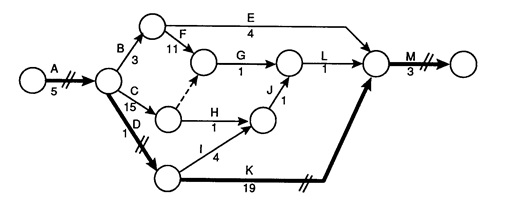
Figure 4.1: Sample Activity-on-Arrow Network Diagram
…has the equivalent precedence diagram in Figure 4.2:
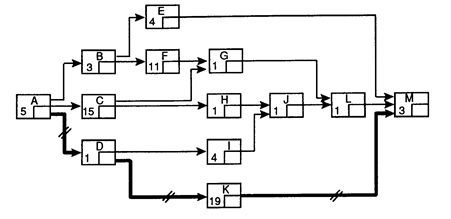
Figure 4.2: Precedence Diagram for AOA Network of Figure 4.1
Note that here we show the critical paths in both figures with a tagged and also denser line.
An ACTIVITY is one step in a programme of work which must have a recognisable start and finish. It may consist of several operations.
In Figure 4.3, activity number L6 (DISMANTLE COMPONENTS) has a duration of 4 days, and must be completed (before) the 5 days required for REPAIR BEARINGS which is activity number L8.

Figure 4.3
Activity
Further information can be included in the activity boxes. Open our Library web page and search the catalogue for Project Planning and Control by Lester, an electronic book. Figure 12.1 in Chapter 12 shows one way of showing ES, LS, EF, LF, Total float and Duration. A percentage line can be added across the bottom of a box to show a stage of completion required before the next activity starts.
A disadvantage is that for complex networks the diagram can take a lot of space, and the resulting clutter can hinder quick interpretation.
Some of the other advantages of the precedence method are:
- each activity is given a unique number, which can be encoded for classification by geographical location, type of work, etc;
- activity title or descriptions can be given in the boxes, as in Figure 4.3;
- ‘dummy’ activities are not required;
- the diagram is simple: so it is easy to follow the planned sequence of work;
- it is easy to add or take away activities on the network;
- link lines can have a time duration and this reduces the number of activities which need to be shown for any given project; and
- link lines can specify different types of activity interdependencies as below in Figure 4.4.
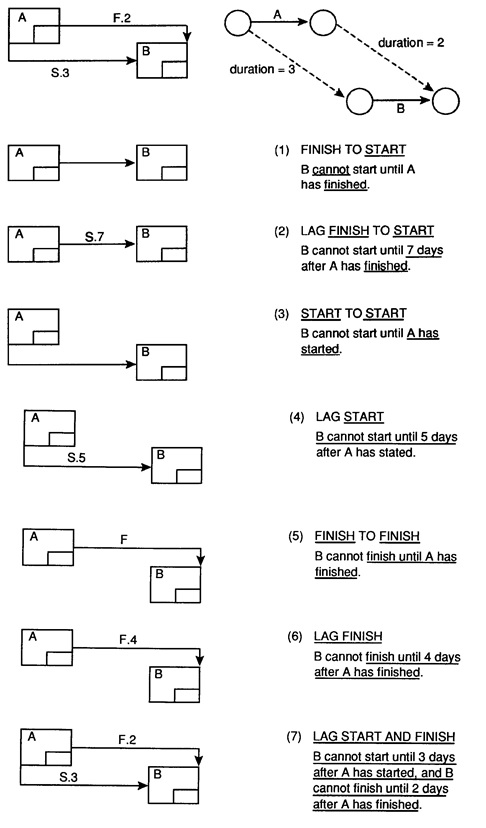
Figure 4.4: Summary of Elements
Look at Figures 25 and 26 in the Lilley Reader article for another comparison between appearance of AOA and AON network presentations. (“New methods” in 1985 are now commonplace – aren’t they?)
2. Program evaluation and review technique
2.1 Calculation of probability of meeting target completion dates
Activity
If you need some basic statistics, or just a brush-up, see Meredith and Mantel (2003), Project management: A managerial approach, 5th edition, Wiley). Or, check what the Library has available, in paper or electronic format.
PERT is a statistical approach that was developed to estimate the possible duration of work that is being carried out for the first time. PERT methods take account of activities which are likely to have a wide range of durations and costs. How should time be assigned? On the basis of the lowest possible cost, the shortest time, or something else?
The vertical scale in the sketches of Figure 4.5 is the number of data points at each value.
These would form a stepped chart, but if enough values are used, a smooth curve results. The left “most likely” plot is called the Normal Distribution. The peak of this symmetrical bell-shaped curve shows the mean of the distribution. Many random variables, data sets and distributions can be approximated as normal distributions.
However, life in the maintenance world is not always like that, and the spread of times to completion is often likely to be a skewed distribution, as in the other two curves in Figure 4.5.
PERT uses probability theory to measure the probability of achieving predicted durations in terms of “most likely”, “optimistic” and “pessimistic” time estimates. It is clear that the “optimistic” and the “pessimistic” time should occur least often and the “most likely” time should occur most often. Thus it is assumed that the most likely time represents the peak or modal value of a probability distribution; however it can move between the two extremes. These characteristics are best described by the Beta distribution.
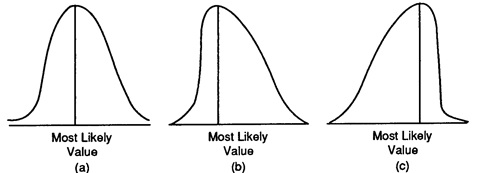
Figure 4.5
Distribution Curves (a) Normal bell-shaped, (b) and (c) beta distributions, skewed.
In a Normal or bell shaped curve (a), the most likely time is the expected time. In the skewed distribution, the PERT developers came up with this approximation for the expected time, te, as the weighted average given by

…and will lie to the right or left of the most likely value, depending on the three time figures. Studies show the error involved calculating te in a Beta distribution is negligible in most industrial applications (e.g. Thierauf and Klekamp (1975), Decision making through operations research, Wiley).
If the duration of an activity is known with certainty, then a = m = b. It is also possible that a = m, and further that m = b. The beta distribution handles all of these extremes.
How reliable are these three estimates? The Delphi method is one way of combining the independent views of several people. In this application, each is asked independent of being influenced by the opinion of others. The mean in each category is used as the best estimate.
Recall that the standard deviation is a measure of the relative spread of a probability distribution about its mean. The difference between a and b is the widest possible overall duration of a project, and is close to ± 3 standard deviations, or one sixth of its range, giving

(The variance, another measure of the uncertainty, is the square of the standard deviation).
MSProject uses these terms in PERT to calculate the “Duration” (we call this the expected time te):
- Optimistic: (best case)
- Expected: we call this “Most likely”
- Pessimistic: (worst case)
The default PERT weighting is 1-4-1, but MSProject allows you to change this. For example, use of 1-3-2 weighting gives a little more pessimism for better risk management.
Note also that there are some difficulties with PERT (Winston, 1994). It is assumed that activity durations are independent, but this may be hard to justify. The durations may not follow a beta distribution. The critical path found by CPM may alter, for example, if an activity was delayed, and another completed ahead of schedule, the critical path will alter. Advance methods can be applied, such as Monte Carlo simulation.
If you want another view on statistics, Patrick O’Connor, author of the textbook we use in the reliability engineering units, wrote a tutorial based on the book: Variation in Reliability and Quality. You can see it via the Library electronic journals under “Q” Quality and Reliability Engineering International, 2004: 20:807-821.
The statistics provide clues. They do not provide explanations. Statistical results should be taken into account but engineering knowledge must always provide the ultimate basis for decisions. The use of statistical confidence and significance in engineering applications is seldom useful and is often misleading”. (O’Connor)
Now we shall see how we can make practical use of this.
2.2 Probability of finishing a project in a nominated time period
The central limit theorem in statistics can be applied to a PERT network. Here, where a series of activities that are independent and in sequence lie on the critical path, the sum of the individual activity durations will closely form a normal distribution. The mean of the distribution of the sum of the durations will be the sum of the mean of the activities and its variance will be the sum of the variances.
As the shape of the curve is defined by two parameters: its mean and standard deviation (sigma), the area under the normal curve depends on them too. The total area under the curve equals 1, and the area under a vertical section between two points represents the probability that the variable will be between these two points.
This means that the standard normal distribution table can be used to determine the chance of completing a project within any given time period. A z-transformation is required for finding the area, z being the number of standard deviations. We will now see how to do this using a function in EXCEL, and also using statistical tables.
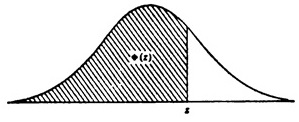
Figure 4.6: Normal Distribution and Central Limit Theorem
Finding probability using EXCEL’s statistical functions
The NORMSDIST function in EXCEL is used. (These steps may vary according to your version of EXCEL - check HELP). Example: What is the probability for a z of 1.1?
- Click on the function wizard: the “= “ sign)
- Type in “NORMSDIST(1.1)”.
The area under the normal curve to the left of z (0.8643) will result.
Activity
As we are assuming that the completion time for a project is normally distributed, there is a:
- 1% chance of completing a project within the time period equal to the mean +1 standard deviation. (Take z = 1);
- 3% chance that the project will be finished within 1 standard deviations of the mean estimated completion time. This is found by taking z = +1, with the area to left = 0.8413 as before, and for z = –1, area to left = 0.1587. The difference is 0.683, or 68.3%;
- 4% chance of completing the project within 2 standard deviations of the mean. Confirm this figure yourself;
- 99% chance of completing within 3 standard deviations. Confirm this figure yourself.
The difference between the most pessimistic and most optimistic time estimates may be approximated as 3 standard deviations. (Does “Six Sigma” ring a bell?)
Finding probability using table of normal distribution
Note that the table following only gives values for up to the right hand half of the curve (i.e. positive values of z).
- 1% chance of completing a project within the time period equal to the mean +1 standard deviation. (Take z = 1, read off value.)
- 3% chance that the project will be finished within 1 standard deviations of the mean estimated completion time. This is found by taking z = +1, with the area to left = 0.8413 as before, and for z = –1, area to left = 1 – 0.8413 = 0.1587. The difference in area is 0.683, or 68.3%.
- 4% chance of completing the project within 2 standard deviations of the mean. Confirm this figure yourself using the table.
- 99% chance of completing within 3 standard deviations. Confirm this figure yourself using the table.
AREA (z) UNDER THE NORMAL CURVE OF THE LEFT OF z
|
z |
0.00 |
0.01 |
0.02 |
0.03 |
0.04 |
0.05 |
0.06 |
0.07 |
0.08 |
0.09 |
|
.0 .1 .2 .3 .4 .5 .6 .7 .8 .9 1.0 |
.5000 .5398 .5793 .6179 .6554 .6915 .7257 .7580 .7881 .8159 .8413 |
.5040 .5438 .5832 .6217 .6591 .6950 .7291 .7611 .7910 .8186 .8438 |
.5080 .5478 .5871 .6255 .6628 .6985 .7324 .7642 .7939 .8212 .8461 |
.5120 .5517 .5910 .6293 .6664 .7019 .7357 .7673 .7973 .8238 .8485 |
.5160 .5557 .5948 .6331 .6700 .7054 .7389 .7704 .7995 .8264 .8508 |
.5199 .5596 .5987 .6368 .6736 .7088 .7422 .7734 .8023 .8289 .8531 |
.5239 .5636 .6026 .6406 .6772 .7123 .7454 .7764 .8051 .8315 .8554 |
.5279 .5675 .6064 .6443 .6808 .7057 .7486 .7794 .8078 .8340 .8577 |
.5319 .5714 .6103 .6480 .6844 .7190 .7517 .7832 .8106 .8365 .8599 |
.5359 .5753 .6141 .6517 .6879 .7224 .7549 .7852 .8133 .8389 .8621 |
|
z |
0.00 |
0.01 |
0.02 |
0.03 |
0.04 |
0.05 |
0.06 |
0.07 |
0.08 |
0.09 |
|
1.1 1.2 1.3 1.4 1.5 1.6 1.7 1.8 1.9 2.0 2.1 2.2 2.3 2.4 2.5 2.6 2.7 2.8 2.9 3.0 3.1 3.2 3.3 3.4 |
.8643 .8849 .9032 .9192 .9332 .9452 .9554 .9641 .9713 .9772 .9821 .9861 .9893 .9918 .9938 .9953 .9965 .9974 .9981 .9987 .9990 .9993 .9995 .9997 |
.8665 .8869 .9049 .9207 .9345 .9463 .9564 .9649 .9719 .9778 .9862 .9864 .9896 .9920 .9940 .9955 .9966 .9975 .9982 .9987 .9991 .9993 .9995 .9997 |
.8686 .8888 .9066 .9222 .9357 .9474 .9573 .9656 .9726 .9788 .9834 .9871 .9901 .9925 .9943 .9957 .9968 .9977 .9983 .9988 .9991 .9994 .9996 .9997 |
.8708 .8907 .9082 .9236 .9370 .9484 .9582 .9664 .9732 .9788 .9834 .9871 .9901 .9925 .9943 .9957 .9968 .9977 .9983 .9988 .9991 .9994 .9996 .9997 |
.8729 .8925 .9099 .9251 .9382 .9495 .9591 .9671 .9738 .9793 .9838 .9875 .9904 .9927 .9945 .9959 .9969 .9977 .9984 .9988 .9992 .9994 .9996 .9997 |
.8749 .8944 .9115 .9265 .9394 .9505 .9599 .9678 .9744 .9798 .9842 .9878 .9906 .9929 .9946 .9960 .9970 .9978 .9984 .9989 .9992 .9994 .9996 .9997 |
.8770 .8962 .9131 .9279 .9406 .9515 .9608 .9686 .9750 .9803 .9846 .9881 .9909 .9931 .9948 .9961 .9971 .9979 .9985 .9989 .9992 .9995 .9996 .9997 |
.8790 .8980 .9147 .9292 .9418 .9525 .9616 .9693 .9756 .9808 .9850 .9884 .9911 .9932 .9949 .9962 .9972 .9979 .9985 .9989 .9992 .9995 .9996 .9997 |
.8810 .8997 .9162 .9306 .9429 .9535 .9625 .9699 .9761 .9812 .9854 .9887 .9913 .9934 .9951 .9963 .9973 .9980 .9986 .9990 .9993 .9995 .9996 .9997 |
.8830 .9015 .9177 .9319 .9441 .9545 .9633 .9706 .9767 .9817 .9857 .9890 .9916 .9936 .9952 .9964 .9974 .9981 .9986 .9990 .9993 .9995 .9997 .9998 |
Activity
Did you repeat the above calculations using the tables?
3. Example 4A: PERT application
Let us now look more closely at how we can use this knowledge in practice. Do remember that even though this method implies precision in its results, all is based on the accuracy of the initial data. Are probabilities finer than to the nearest percentage point valid?
A plant improvement project consists of the activities in the table. The planners have estimated the durations as shown.
What is the probability that the job will be completed within the 28 weeks that have been allocated?
|
Activity i-j |
Optimistic Duration (weeks) |
Most Likely Duration (weeks) |
Pessimistic Duration (weeks) |
|
1 – 2 1 – 3 1 – 4 2 – 5 3 – 6 4 – 6 4 – 8 5 – 7 6 – 9 7 – 9 8 – 9 |
3 2 3 4 2 7 4 6 5 2 4 |
8 5 8 7 3 9 6 9 7 5 6 |
13 8 10 10 8 10 9 12 11 14 9 |
Activity
Cover up the next page, and try and sketch out the AOA network for this project.
Solution
The first step in solving this problem is to calculate the expected time and standard deviation on the estimates for each activity on the critical path, using the formulae given earlier:

|
Activity |
a |
m |
b |
te |
a |
|
1 – 2 1 – 3 1 – 4 2 – 5 3 – 6 4 – 6 4 – 8 5 – 7 6 – 9 7 – 9 8 – 9 |
3 2 3 4 2 7 4 6 5 2 4 |
8 5 8 7 3 9 6 9 7 5 6 |
13 8 10 10 8 10 9 12 11 14 9 |
8 5 7.5 7 3.6 8.8 6.2 9 7.3 6 6.2 |
1.7 1 1.17 1 1 0.5 0.83 1 1 2 0.83 |
These estimated times can now be transferred onto the corresponding activity on the AOA network.
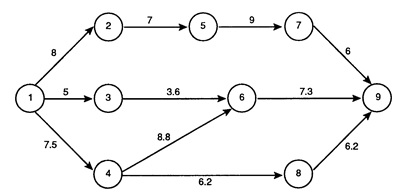
Figure 4.7
Here are the possibilities:
1-3-6-9 = 15.9 weeks
1-4-6-9 = 23.6 weeks
1-4-8-9 = 19.9 weeks
1-2-5-7-9 = 30 weeks and as this is the longest path, it is the critical path.
The standard deviation of this time estimate for the critical path is given by:

where a = standard deviation of each of the activities on the critical path.

But, we want to find the probability of completing the job in 28 weeks. The difference must be obtained terms of standard deviations, so that we can use the statistical tables or the EXCEL functions described above.
30 – 28 = 2 weeks, giving 2 /2.98 = 0.67 standard deviations
i.e. from the normal distribution curve (tables, or EXCEL NORMSDIST)
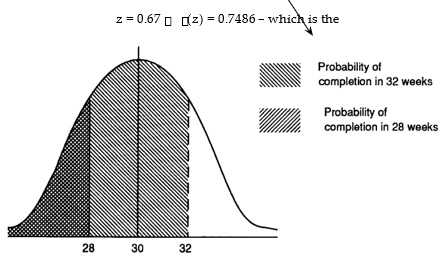
Figure 4.8
The table gives the area under the curve up to the z value. So, the 0.7486 we got applies for 32 weeks. Fig. 4.8 illustrates this. We want the probability of completion in 28 weeks, which is less than the mean, so
Probability of completion in 28 weeks.
= 1 – (probability of completion in 32 weeks).
(Chart is drawn only for entries to the right hand half of the curve. Note that z = 0 (z) = 0.5.)
As already obtained, the probability of completion in 32 weeks is 0.7486.
Probability of completion in 28 weeks = 25% ANSWER.
4. Example/activity 4B
This example is along similar lines to Example 4A, but is incomplete.
A maintenance contractor wants to complete work on a critical item of plant in 24 hours. If the work can be completed in that time there will be a lucrative bonus payment.
PERT techniques are to be used to schedule and control the outstanding work program.
Table 1 below lists the 11 major activities to be completed and their estimated durations.
What is the probability that the program will be completed within 24 hours?
|
Activity |
Optimistic Duration (hours) |
Most Likely Duration (hours) |
Pessimistic Duration (hours) |
|
1-2 |
3 |
8 |
12 |
|
1-3 |
4 |
7 |
10 |
|
1-4 |
3 |
5 |
10 |
|
2-5 |
2 |
4 |
8 |
|
3-6 |
2 |
3 |
5 |
|
4-6 |
5 |
7 |
8 |
|
4-8 |
3 |
5 |
8 |
|
5-7 |
5 |
8 |
11 |
|
6-9 |
4 |
6 |
10 |
|
7-9 |
2 |
6 |
14 |
|
8-9 |
4 |
5 |
9 |
Table 1
Follow the steps as before in Example 4A. If you do not get an answer of 16%, you need to check and see why not!
An important point is that if you decide to have a safety margin, this should only be added to the critical path, and at one place, not at every activity separately.
5. Activity 4C
Activity
Try this problem below by yourself, then check again independently to compare your answer.
You are the Maintenance Manager, and your planner has been working on an upcoming outage. She shows you this table of the list of activities, each with their durations. “I reckon that we can do it in 36 weeks, with a probability of 99%” she says. If you do agree, what duration would you suggest? Draw the network.
|
Activity i - j |
Optimistic Duration (weeks) |
Most Likely Duration (weeks) |
Pessimistic Duration (weeks) |
|
1-2 |
2 |
7 |
8 |
|
2-3 |
5 |
6 |
9 |
|
2-4 |
3 |
7 |
8 |
|
2-5 |
4 |
5 |
6 |
|
3-6 |
6 |
9 |
10 |
|
4-7 |
6 |
8 |
11 |
|
5-7 |
4 |
6 |
7 |
|
6-8 |
5 |
7 |
10 |
|
7-8 |
4 |
8 |
9 |
|
8-9 |
4 |
7 |
9 |
6. Crashing networks – time/cost optimisation
Reduction of the activity times is often desirable so as to make up for time lost through unforeseen delays and breakdowns. This reduction can only be achieved at additional cost, through the need for overtime, additional equipment, etc.
To reduce the project time, critical activity times must be reduced. This could result in previously non critical activities forming new or additional critical paths. As activities represent independent phases of work, relative costs will vary according to the nature and quantity of resources required. Hence there is a need to consider which activities will involve the least cost for each reduction of unit time.
The basic procedure of PERT cost optimisation is based upon the preparation of time-cost data for each activity of a network. Using this information a sequence of alternate analysis and re-scheduling of activities is used to determine the optimum cost relationship.
6.1 Activity time/cost data
Estimates of activity cost are usually made on a “most economical” individual activity basis, and in this case the cost of each activity is referred to as the NORMAL COST.
When reducing the duration of each individual activity there is a limit beyond which no additional allocation of resources will reduce the activity time further. This limit is called the CRASH POINT and the cost to achieve this is called the CRASH COST.
The relationship of time reduction to cost can be considered as linear even though the actual relationship will depend on a number of factors not necessarily applicable to all activities.
Consider Figure 4.9 below which shows an activity with a normal duration of 6 days at a cost of $100. By spending more money on resources, it can be completed in 3 days at a crash cost of $250. This means that each day’s reduction in time costs $50 in this case. Note that it may not be possible to crash every activity in a project, but each one that can be crashed will have a curve of this nature.
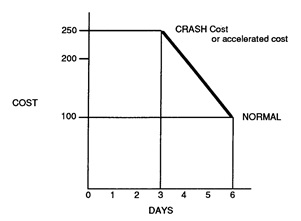
Figure 4.9
It is possible that only certain durations are feasible. For example, the duration may be three days (crashed) or six days (normal) but not four or five days (because of number of people required, etc). Or, in another situation, it may be possible to schedule a duration anywhere between three days and six days.
Using this approximation any activity can be analysed to ensure that the minimum additional total cost is incurred.
7. Example 4D
Determine the minimum cost of completing the project shown in the shortest possible time using the time/cost data tabulated. (Note: the dollar numbers are for illustration and of course not meant to reflect today’s real costs. Call them thousands if you like!).
The crash cost rate/day is the incremental extra cost divided by the number of days saved, e.g. for Activity 4-6, the rate/day = (320 – 120) (4-2) = $100/day.
|
Normal |
Crash |
Crash cost rate/day $ | |||
|
Activity |
Days |
Cost $ |
Days |
Cost $ | |
|
1-2 1-3 1-4 2-5 3-6 4-6 5-6 |
2 1 3 1 2 4 2 |
60 25 100 25 30 120 40 |
1 1 2 1 1 2 1 |
80 25 150 25 50 320 65 |
20 - 50 - 20 100 25 |
|
Totals |
400 |
715 | |||
Note that the total cost of normal working is $400, and if we crashed every activity where this can be done, the cost would total $715.
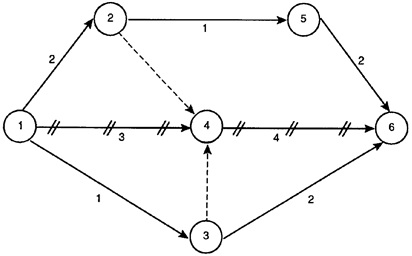
Figure 4.10
If all the activities were crashed, additional expenditure may be incurred on activities not affecting the project duration. On the other hand if only the critical path activities were crashed, the project duration could be determined by a new critical path which became longer than the original critical path we selected to crash.
The procedure is to reduce critical activities progressively until all activities on the critical path are at their crash limit; or until any further reduction of a critical activity will not achieve a similar reduction to the project time. Setting this progressive procedure out in a table format can help.
|
Project Duration |
Obtained by Reducing |
Additional Direct Cost |
Total Direct Cost |
Notes |
|
7 Days |
Normal completion time |
400 |
Critical Path is 1-4-6 | |
|
6 Days |
1-4 by 1 day |
50 |
450 |
4-6 could be crashed, but costs more at $100/day. 1-2 now also critical through activities 1-2, dummy 2-4 and 4-6. We have two parallel critical paths. Project cost has risen by $50. |
|
5 Days |
4-6 by 1 day |
100 |
550 |
Two critical paths to consider. 1-2 and 1-4 must both be reduced simultaneously to shorten project duration by 1 day, but activity 1-4 is already at its crash limit. Hence activity 4-6 must be reduced by 1 day at additional cost of $100. 2-5, 5-6 now also critical, so we now have 3 critical paths, i.e. 1-4-6 and 1-2-4-6 and 1-2-5-6. |
|
4 Days |
4-6 by 1 day 5-6 by 1 day |
100 25 |
675 |
Can only be achieved by reducing 4-6 to its crash limit of 2 days and 5-6 to its crash limit of 1 day. A further reduction of 1-2 to 1 day would not reduce project duration. Hence 4 days is the shortest possible duration. |
Had all the activities been reduced to their crash limit the project would have cost $715, but by using PERT logic the same result has been achieved at the least possible cost $675.
7.1 Total project cost
Total cost consists of two kinds of expenditure.
Direct cost
Examples of direct costs are wages, overtime, penalty payments, hiring additional equipment, material costs, etc. As the activity duration is reduced direct cost will rise in proportion to the amount of additional resources employed. The graph in Figure 4.11 shows, for our example above, the relationship between direct cost and overall duration.
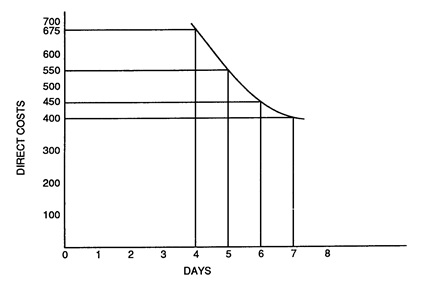
Figure 4.11
Indirect costs
Are those which cannot be attributed to any individual activity but are incurred in the operation of the organisation as a whole, such as accommodation, rental, administration, heating, lighting, interest on capital investment.
These costs are charged to the project as a whole, and increase as the project duration increases. We shall take $50/day in our example, with Figure 4.12 showing the trend, rising continuously from zero at zero time.
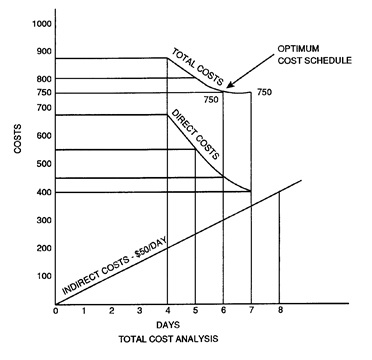
Figure 4.12
Total costs
These are determined by summing the two lower curves as shown (manually, or with
EXCEL), to result in the top curve of Figure 4.12. You will notice that here the Optimum Cost Schedule occurs on either a 6 or 7 day duration. A total project cost of $750 is involved whether the project is completed in either 6 or 7 days (i.e. $450 + 300 or $450 + $300). Here, indirect costs alone make it economic to crash the project duration to 6 days: the job costs no more to finish 1 day earlier!
By linking costs and duration, the network acquires a flexibility which makes it easier to control. A manager may either manipulate costs to adjust the project completion date, or vary the project completion date in order to minimise cost.
This is a most useful technique for pre-tender planning; especially if the project plan based on normal activity times will exceed the specified contract time. The method would also lead to discovery of the most cost efficient method of bringing a delayed construction contract back on target.
Always remember that when there are two or more critical paths, they must be simultaneously crashed in order to reduce project duration.
8. Activity 4E
The AON network in Figure 4.13 represents the shutdown overhaul of a plant installation. Each day the plant is off line costs $300 (here this is the indirect cost). The table gives a list of activities with normal and crash durations and costs.
Activity
Determine the minimum total cost and the optimum time for the project.
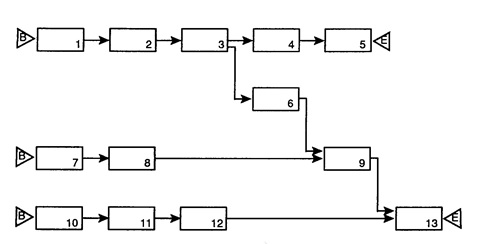
Figure 4.13
|
Activity |
Normal |
Crash |
Cost Rate $/day | ||
|
Days |
Cost $ |
Days |
Cost $ | ||
|
1 |
16 |
3000 |
12 |
3800 | |
|
2 |
6 |
1200 |
5 |
1250 | |
|
3 |
9 |
1300 |
7 |
1500 | |
|
6 |
9 |
1500 |
7 |
1600 | |
|
4 |
17 |
3300 |
14 |
3900 | |
|
5 |
11 |
2400 |
11 |
2400 | |
|
7 |
20 |
3800 |
16 |
4000 | |
|
8 |
18 |
3300 |
15 |
3900 | |
|
9 |
14 |
3000 |
11 |
3300 | |
|
13 |
12 |
2400 |
12 |
2400 | |
|
10 |
17 |
2500 |
13 |
2700 | |
|
11 |
14 |
2100 |
14 |
2100 | |
|
12 |
12 |
1800 |
8 |
2400 | |
Crashing activities on the critical path increases activity costs but the saving in project duration reduces overall costs. In our exercise, the reduction in overall cost due to reduction in project duration is given as $300/day.
Increases in activity costs due to crashing can be found. Cover up the next table. Figure out the cost rate/day of each activity, and write them in the table above.
|
Activity |
Normal |
Crash |
Crash Cost Rate $/day |
Float | ||
|
Days |
Cost $ |
Days |
Cost $ | |||
|
1* |
16 |
3000 |
12 |
3800 |
200 |
0 |
|
2* |
6 |
1200 |
5 |
1250 |
50 |
0 |
|
3* |
9 |
1300 |
7 |
1500 |
100 |
0 |
|
6* |
9 |
1500 |
7 |
1600 |
50 |
0 |
|
4 |
17 |
3300 |
14 |
3900 |
200 |
7 |
|
5 |
11 |
2400 |
11 |
2400 |
0 |
7 |
|
7 |
20 |
3800 |
16 |
4000 |
50 |
2 |
|
8 |
18 |
3300 |
15 |
3900 |
200 |
2 |
|
9* |
14 |
3000 |
11 |
3300 |
100 |
0 |
|
13* |
12 |
2400 |
12 |
2400 |
0 |
0 |
|
10 |
17 |
2500 |
13 |
2700 |
50 |
11 |
|
11 |
14 |
2100 |
14 |
2100 |
0 |
11 |
|
12 |
12 |
1800 |
8 |
2400 |
150 |
11 |
|
31600 | ||||||
Normal duration through critical path 1-2-3-6-9-13 is 66 days.
Activities 5, 11 and 13 cannot be crashed, so their duration and costs are unchanged.
Critical activities have zero float, i.e. activities 1, 2, 3, 6, 9 and 13. Start by crashing the cheapest way the possible critical activities. Here, activities 2 and 6 at $50 per day are the lowest cost. Let us work through progressively. You can modify the network information and critical path/s as we go if you like.
|
Project Duration |
Obtained by Reducing |
Additional Direct Cost |
Total Direct Cost |
Notes |
|
66 days |
Normal duration |
31600 | ||
|
64 days |
Activity 6 by 2 days |
2 × 50 = 100 |
31700 |
Float of 7 and 8 is now used up, giving a second critical path in parallel: 7-8-9-13, so we need to crash an activity on both critical paths. |
|
63 days |
Activities 7 and 2 by 1 day |
2 × 50 = 100 |
31800 |
Activity 9 is on both critical paths, so crash it. |
|
60 days |
Activity 9 by 3 days |
3 × 100 = 300 |
32100 |
Two critical paths still, one new, so need to crash an activity on each path. |
|
58 days |
Activities 7 and 3 by 2 days |
2 × 50= 100 2 × 100= 200 |
32400 |
Crash an activity on each path. |
|
57 days |
Crash activities 7 and 1 by 1 more day each |
1 × 200= 200 1× 50 = 50 |
32650 | |
Note: After all these steps, the only activities on the 2 parallel critical paths yet to be crashed completely are activities 1 and 8, each costing $200 per day extra.
Both would need to be done to shorten the duration. Together the cost is $400 per day which is greater than the available saving of $300 per day and is, therefore, not worthwhile.
Optimal project time is thus 57 days
Using normal activity time, the total cost is $31,600 + 66 300 = $51,400
Crashing, the total cost would be $32650 + (57 x 300) = $49,750
Figure 4.14 shows the plot resulting from entering the data into EXCEL as we did in
Example 4D, using here the cost of lost production as the indirect cost of the project.
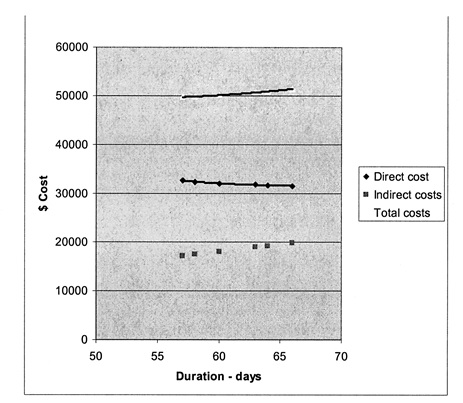
Figure 4.14: Total Costs for Example 4E
9. Activity 4F
It is time to try by yourself.
The activities for a maintenance job are shown in the table, with durations and estimates of costs. To check the effect of completing the job more quickly, further estimates of crash duration and the resulting higher costs have been made.
|
Activity |
No |
rmal |
Crash |
Crash Cost Rate $/day |
Float |
|
(days) |
($) |
(days) |
($) | ||
|
1-2 |
5 |
600 |
3 |
800 | |
|
1-3 |
4 |
200 |
3 |
400 | |
|
2-4 |
3 |
150 |
3 |
150 | |
|
2-5 |
2 |
400 |
2 |
400 | |
|
3-4 |
7 |
200 |
3 |
500 | |
|
4-7 |
3 |
150 |
1 |
250 | |
|
4-8 |
5 |
300 |
4 |
400 | |
|
5-6 |
6 |
660 |
3 |
900 | |
|
6-9 |
5 |
200 |
2 |
500 | |
|
7-9 |
7 |
160 |
5 |
210 | |
|
8-9 |
4 |
100 |
3 |
130 |
Calculate:
- the total cost of both methods of performing the work;
- the optimised direct cost of carrying out the work in the crash overall duration; and
- the optimum duration of the job when overheads and other indirect costs of $100 per day are included.
When you have completed your work, try again from scratch. If your answer differs, then check what might be problem and try again.
A table layout, as shown following, helps keep track of each step, and I strongly suggest that you adopt it.
|
Project Duration |
Obtained by Reducing |
Additional Direct Cost |
Progressive Total Direct Cost $ |
Progressive Total Cost $ |
Notes |
|
Normal Duration | |||||
10. GERT: A conditional sequencing/scheduling method
CPM/PERT analysis methods do not allow network loops (e.g. a project test that may be repeated more than once) or conditional branches (e.g. a design upgrade that occurs only if an inspection detects errors) in their sequenced networks. GERT (graphical evaluation and review technique) is a diagramming method that “combines signal flowgraph theory, probabilistic networks, CPM/PERT, and decision trees all in a single framework” (Meredith and Mantel, 1995).
GERT utilises complex probabilistic and branching nodes. These nodes can specify both the number of activities leading to them which must be realised, and the potential multiple branching paths that can emanate from them. When each branching activity has an assigned probability of occurrence, the sum of the probabilities over all the branches is 1.0. When no probabilities are assigned for the branches, it is automatically assumed that the probability is 1.0 for each branch (i.e. every branch must be taken).
Typical GERT node nomenclature has been extracted from Nicholas, J.M. (1990), Managing business and engineering projects, Prentice-Hall, Englewood Cliffs, and is shown in Figure 4.15:

Figure 4.15: GERT Node Nomenclature
Figure 4.15(a) represents a node that can be reached the first time by completing any two (top left hand quadrant) of the input activities a, b, or c. If the node is reached again (through looping), only one of a, b, or c need be completed (refer lower left hand quadrant). When the node is reached, both activities d and e can commence.
Figure 4.15(b) signifies that all preceding activities (a and b) must be completed before the node is reached. The infinity symbol means that the node cannot be subsequently reached (i.e. no network loops are permitted back to it). When the node is reached, activities c, d, or e will commence with probabilities of occurrence of 0.3, 0.4, and 0.3, respectively.
A comparison of GERT and CPM/PERT characteristics is illustrated in this table (adapted from Meredith and Mantel, 1995):
|
GERT Characteristics |
CPM/PERT Characteristics |
|
Branching from a node is probabilistic |
Branching from a node is deterministic |
|
Various probability distributions for time estimates are possible |
Only the beta probability distribution for time estimates is possible |
|
Flexibility in node realisation is possible |
No flexibility in node realisation is possible |
|
Looping back to earlier events is acceptable |
Looping back is not permitted |
|
Difficult to use as a control tool |
Simple to use for control |
|
Arcs may represent time, cost, reliability, etc |
Arcs represent time only |
I suggest that you should always aim to adopt the simplest sequencing/scheduling technique that is consistent with the needs of your project. While a thorough GERT analysis can be more comprehensive than the simpler CPM/PERT analyses, both the input information and the computational requirements are far more extensive for a GERT analysis.
Next up, we consider outage management as a special case of project management.
Diploma Universities Assignments
Laureate International Universities Assignment
Holmes Institute Assignment
Tafe NSW
Yes College Australia
ACC508 Informatics and Financial Applications Task 2 T2, 2019
ACC512 Accounting
ACC520 Legal Regulation of Business Structures Semester 2, 2019
ACCT20074 Contemporary Accounting Theory Term 2 Assessment 3
AERO2463 Computational Engineering Analysis : Assignment 4
B01DBFN212 Database Fundamentals Assessment 1
BE01106 - Business Statistics Assignment
BFA301 Advanced Financial Accounting
BFA504 Accounting Systems Assessment 3
BSB61015 Advanced Diploma of Leadership and Management
BSBADV602 Develop an Advertising Campaign
BSBCOM603 Plan and establish compliance management systems case study
BSBCOM603 Plan and establish compliance management systems Assessment Task 1
BSBCOM603 Plan and establish compliance management systems Assessment Task 2
BSBCOM603 Plan and establish compliance management systems Assessment Task 3
BSBFIM501 Manage Budgets And Financial Plans Assessment Task 1
BSBHRM602 Manage Human Resources Strategic Planning
BSBINM601 Manage Knowledge and Information
BSBWOR501 Assessment Task 3 Plan Personal Development Plan Project
BSBMGT517 Manage Operational Plan
BSBWHS521 Ensure a Safe Workplace For a Work Area
BSBWRK510 Manage employee relations
BUSS1030 Accounting, Business and Society
CAB202 Microprocessors and Digital Systems Assignment Help
CHC40213 Certificate IV in Education Support
CHCAGE001 Facilitate the empowerment of older people
CHCAGE005 Provide support to people living with dementia
CHCCCS023 Support independence and wellbeing
CHCCCS025 Support relationships with carers and families
CHCCOM005 Communicate and CHCLEG001 Work Legally Ethically
CHCDIS002 Follow established person-centred behaviour supports
CHCECE019 Early Childhood Education and Care
CHCHCS001 Provide home and community support services
COMP10002 Foundations of Algorithms
COMP90038 Algorithms and Complexity
COSC2633/2637 Big Data Processing
COSC473 Introduction to Computer Systems
CPCCBC5011A Manage Environmental Management Practices And Processes In Building And Construction
CPCCBC5018A Apply structural Principles Medium rise Construction
CSE3OSA Assignment 2019
ELEC242 2019 Session 2
ENN543 Data Analytics and Optimisation
ENN543 Data Analytics and Optimisation Semester 2, 2019
FINM202 Financial Management Assessment 3 Group Report
Forensic Investigation Case Assignment ECU University
HA2042 Accounting Information Systems T2 2019
HC1010 Holmes Institute Accounting For Business
HC2112 Service Marketing and Relationship Marketing Individual Assignment T2 2019
HC2121 Comparative Business Ethics & Social Responsibility T2 2019
HI5002 Holmes Institute Finance for Business
HI5003 Economics for Business Trimester 2 2019
HI5004 Marketing Management T1 2020 Individual Report
HI5004 Marketing Management T1 2020 Group Report
HI5004 Holmes Institute Marketing Management
HI5014 International Business across Borders Assignment 1
HI5014 International Business across Borders
HI5017 Managerial Accounting T2 2019
HI5017 Managerial Accounting T1 2019
HI5019 Tutorial Questions 1
HI5019 Strategic Information Systems for Business and Enterprise T1 2020
HI5019 Holmes Institute Strategic Information Systems T2
HI5019 T2 2019
HI5019 T1 2019
HI5020 Corporate Accounting T3 2019
HI5020 Corporate Accounting T2 2019
HI6005: Management and Organisations in a Global Environment
HI6006 Tutorial questions
HI6006 Competitive Strategy Individual T1 2020
HI6006 Holmes Institute Competitive Strategy
HI6006 Competitive Strategy T3 2019
HI6007 Statistics for business decisions
HI6007 Assessment 2 T1 2020
HI6007 T1 2019
HI6008 T2 2019
HI6008 Holmes Institute Research Project
HI6025 Accounting Theory and Current Issues
HI6026 Audit, Assurance and Compliance Assignment Help
HI6026 Audit, Assurance and Compliance
HI6027 business and corporate law tutorial Assignment T1 2021
HI6027 Business and Corporate Law T3 2019
HI6027 Business and Corporate Law T2 2019
HI6028 Taxation Theory, Practice and Law T2 2021
Hi6028 taxation theory, practice and law Final Assessment t1 2021
HI6028 Taxation Theory, Practice and Law T2 2019
HI6028 Taxation Theory T1 2019
HI6028 Taxation Law Holmes
HLTAAP001 Recognise healthy body systems
HLTWHS002 Follow safe practices for direct client care
HOTL5003 Hotel Property and Operations
HPS771 - Research Methods in Psychology A
HS2021 Database Design
ICTICT307 Customise packaged software applications for clients
IFN619 Data Analytics for Strategic Decision Makers
INF80028 Business Process Management Swinburne University
ISY2005 Case Assignment Assessment 2
ISYS326: Information Systems Security Assignment 2, Semester 2, 2019
ITAP3010 Developing Data Access Solutions Project
ITECH1103- Big Data and Analytics – Lab 3 – Working with Data Items
ITECH1103- Big Data and Analytics Assignment Semester 1, 2020
ITECH 5500 Professional Research and Communication
Kent Institute Australia Assignment
MA5830 Data Visualisation Assignment 2
MGMT7020 Project Management Plan
Mgt 301 Assessment 3
MGT215 Project Management Individual Assignment
MIS102 Data and Networking Assignment Help
MITS4002 Object Oriented Software Development
MITS5002 Software Engineering Methodology
MKT01760 Tourism Planning Environments Assessment 4
MKT01760 Tourism Planning Environments
MKT01906 International Tourism Systems
MKT5000 Marketing Management S2 2019
MNG03236 Report Writing SCU
MRE5003 Industrial Techniques In Maintenance Management Assignment 4
MRE5003 Industrial Techniques In Maintenance Management Assignment 3
MRE5003 Industrial Techniques In Maintenance Management
Network Security and Mitigation Strategies Answers
NIT2213 Software Engineering Assignment
NSB231 Integrated Nursing Practice Assessment Task 1
Science Literacy Assessment 4
SIT323 Practical Software Development T 2, 2019
SIT718 Using aggregation functions for data analysis
SITXCOM002 Show Social and Cultural Sensitivity
TLIL5055 Manage a supply chain
TLIR5014 Manage Suppliers
USQ ACC5502 Accounting and Financial Management
UTS: 48370 Road and Transport Engineering Assessment 2
CHCAGE001 Facilitate the empowerment of older people
CHCAGE005 Provide support to people living with dementia
CHCCCS011 Meet personal support needs
CHCCCS015 Provide Individualised Support
CHCCCS023 Support independence and wellbeing
CHCCCS025 Support relationships with carers and families
CHCCOM005 Communicate and work in health or community services
CHCDIS001 Contribute to ongoing skills development
CHCDIS002 Follow established person-centred behaviour supports
CHCDIS003 Support community participation and social inclusion
CHCDIS005 Develop and provide person-centred service responses
CHCDIS007 Facilitate the empowerment of people with disability
CHCDIS008 Facilitate community participation and social inclusion
CHCDIS009 Facilitate ongoing skills development
CHCDIS010 Provide person-centred services
CHCDIV001 Work with diverse people
CHCHCS001 Provide home and community support services
CHCLEG001 Work legally and ethically
CHCLEG003 Manage legal and ethical compliance
HLTAAP001 Recognise healthy body systems
HLTAID003 Provide First Aid
HLTHPS007 Administer and monitor medications
HLTWHS002 Follow safe work practices for direct client care
Assignment 2 Introduction to Digital Forensics
MGT603 Systems Thinking Assessment 1
MGT603 Systems Thinking Assessment 2
Hi5017 Managerial Accounting T1 2021
HI6028 Taxation Theory, Practice and Law T1 2021
OODP101 Assessment Task 3 T1 2021
ITNE2003R Network Configuration and Management Project
Australia Universities
ACT
Australian Catholic University
Australian National University
Bond University
Central Queensland University
Charles Darwin University
Charles Sturt University
Curtin University of Technology
Deakin University
Edith Cowan University
Flinders University
Griffith University
Holmes Institute
James Cook University
La Trobe University
Macquarie University
Monash University
Murdoch University
Queensland University of Technology
RMIT University
Southern Cross University
Swinburne University of Technology
University of Adelaide
University of Ballarat
University of Canberra
University of Melbourne
University of Newcastle
University of New England
University of New South Wales
University of Notre Dame Australia
University of Queensland
University of South Australia
University of Southern Queensland
University of Sydney
University of Tasmania
University of Technology Sydney
University of the Sunshine Coast
University of Western Australia
University of Wollongong
Victoria University
Western Sydney University
Year 11 - 12 Certification Assignment
Australian Capital Territory Year 12 Certificate
HSC - Higher School Certificate
NTCE - Northern Territory Certificate of Education
QCE - Queensland Certificate of Education
SACE - South Australian Certificate of Education
TCE - Tasmanian Certificate of Education
VCE - Victorian Certificate of Education
WACE - Western Australia Certificate of Education
Assignment Service Australia | CDR Writing Help | TAFE Assignment Help | Perth Assignment Help | Melbourne Assignment Help | Darwin Assignment Help | Adelaide Assignment Help | Assignment Help Victoria | Sydney Assignment Help | Canberra Assignment Help | Brisbane Assignment Help | CDR for Australian immigration | Course For Australian History


